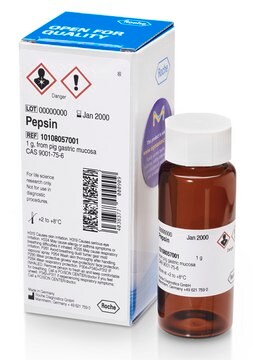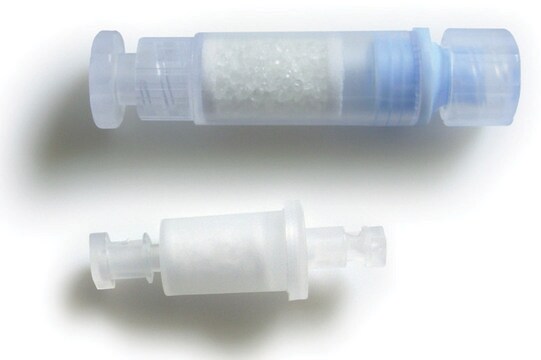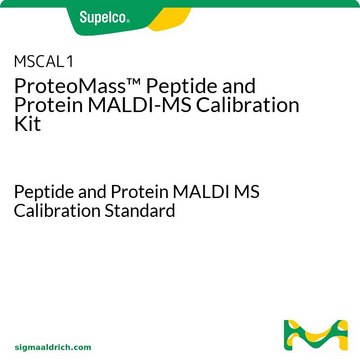662200
Ubiquitinated Protein Enrichment Kit
Iniciar sesiónpara Ver la Fijación de precios por contrato y de la organización
About This Item
UNSPSC Code:
41116133
Productos recomendados
usage
kit sufficient for 12.5-25 mg process (lysate)
Quality Level
manufacturer/tradename
Calbiochem®
storage condition
do not freeze
storage temp.
2-8°C
General description
A rapid method for isolating ubiquitinated proteins using affinity beads comprised of a GST-fusion protein containing an ubiquitin-associated sequence bound to glutathione-agarose. Useful for the enrichment of polyubiquitinated proteins from cell and tissue lysates of a broad range of species including canine, human, mouse, and yeast. The ubiquitinated proteins can be identified by loading the beads directly onto SDS-PAGE and then immunoblotting with the antibody of choice or Anti-Ubiquitin (Cat. No. 662099). Alternatively, it is possible that the beads can be treated with Isopeptidase T (Cat. No. 419700) to release the proteins from the ubiquitin chains.
A vast majority of short-lived proteins are degraded by the ubiquitin-proteasome pathway. A protein marked for degradation is covalently attached to multiple molecules of ubiquitin, a highly conserved 76-amino acid (8.6 kDa) protein, by a multi-enzymatic system consisting of Ubiquitin-activating (E1), Ubiquitin-conjugating (E2), and the Ubiquitin-ligating (E3) enzymes. The E1 activates a Ubiquitin monomer at its C-terminal cysteine residue to a high-energy thiolester bond which is then transferred to a reactive cysteine residue of the E2 enzyme. The final transfer of ubiquitin to e-amino group of a reactive lysine residue of substrate proteins is brought about by the E3 enzyme. Ubiquitinated protein is then escorted to the 26S proteasome where it undergoes final degradation and the ubiquitin is released and recycled. A family of proteins including Rad23, contain two ubiquitin-associated domains that bind ubiquitinated cellular proteins and translocate them to the proteasome. Ubiquitinated proteins can be enriched using affinity beads comprised of a GST-fusion protein containing this ubiquitin-associated sequence conjugated to glutathione-agarose.
Components
Polyubiquitin Affinity Beads, Control Glutathione-Agarose Beads, Control Lysate, and a user protocol.
Warning
Toxicity: Multiple Toxicity Values, refer to MSDS (O)
Storage and Stability
Upon arrival store entire contents of the kit at 4°C.
Other Notes
Chen, L. and Madura, K. 2002. Mol. Cell Biol. 22, 4902.
Chen, L., et al. 2001. EMBO Rep.2, 933.
Chen, L., et al. 2001. EMBO Rep.2, 933.
Legal Information
Sold under license of PCT Application wo 03/049,602.
CALBIOCHEM is a registered trademark of Merck KGaA, Darmstadt, Germany
signalword
Danger
Hazard Classifications
Acute Tox. 4 Dermal - Aquatic Chronic 3 - Eye Dam. 1 - Repr. 2 - Skin Sens. 1
Storage Class
10 - Combustible liquids
Certificados de análisis (COA)
Busque Certificados de análisis (COA) introduciendo el número de lote del producto. Los números de lote se encuentran en la etiqueta del producto después de las palabras «Lot» o «Batch»
¿Ya tiene este producto?
Encuentre la documentación para los productos que ha comprado recientemente en la Biblioteca de documentos.
J Zhu et al.
Oncogene, 33(34), 4340-4351 (2014-01-21)
Estrogen receptor α (ERα) is initially expressed in the majority of breast cancers and promotes estrogen-dependent cancer progression by regulating the transcription of genes linked to cell proliferation. ERα status is of clinical importance, as ERα-positive breast cancers can be
Jian Chen et al.
The American journal of pathology, 175(1), 400-411 (2009-06-17)
Tumor hypoxia directly promotes genomic instability and facilitates cell survival, resulting in tumors with a more aggressive phenotype. The proto-oncogene pim-1 regulates apoptosis and the cell cycle by phosphorylating target proteins. Overexpression of Pim-1 can cause genomic instability and contribute
Christian Ehlting et al.
Scientific reports, 9(1), 11021-11021 (2019-08-01)
The p38MAPK downstream targets MAPKAP kinases (MK) 2 and 3 are critical for the regulation of the macrophage response to LPS. The extents to which these two kinases act cooperatively and distinctly in regulating LPS-induced inflammatory cytokine expression are still
Roi Cal et al.
Arteriosclerosis, thrombosis, and vascular biology, 33(2), 369-377 (2012-12-18)
Low density lipoprotein retention and aggregation in the arterial intima are key processes in atherogenesis. Aggregated LDL (agLDL) is taken up through low-density lipoprotein receptor-related protein 1 (LRP1) by human vascular smooth muscle cells (VSMC). AgLDL increases LRP1 expression, at
Nuestro equipo de científicos tiene experiencia en todas las áreas de investigación: Ciencias de la vida, Ciencia de los materiales, Síntesis química, Cromatografía, Analítica y muchas otras.
Póngase en contacto con el Servicio técnico




![[D-Lys3]-GHRP-6 synthetic, lyophilized powder](/deepweb/assets/sigmaaldrich/product/structures/386/044/971c33d0-e117-4aad-bf07-27172c088df1/640/971c33d0-e117-4aad-bf07-27172c088df1.png)




